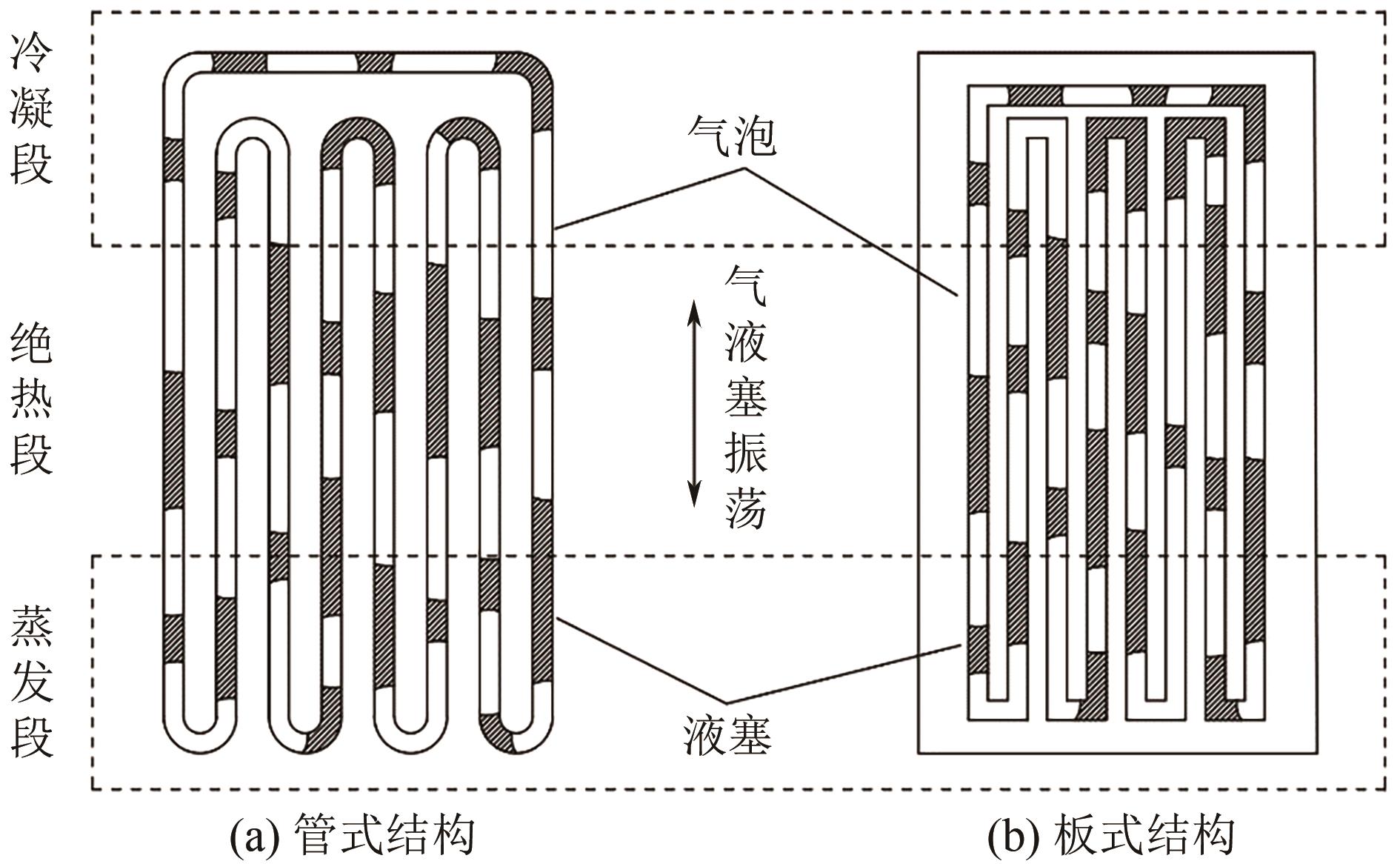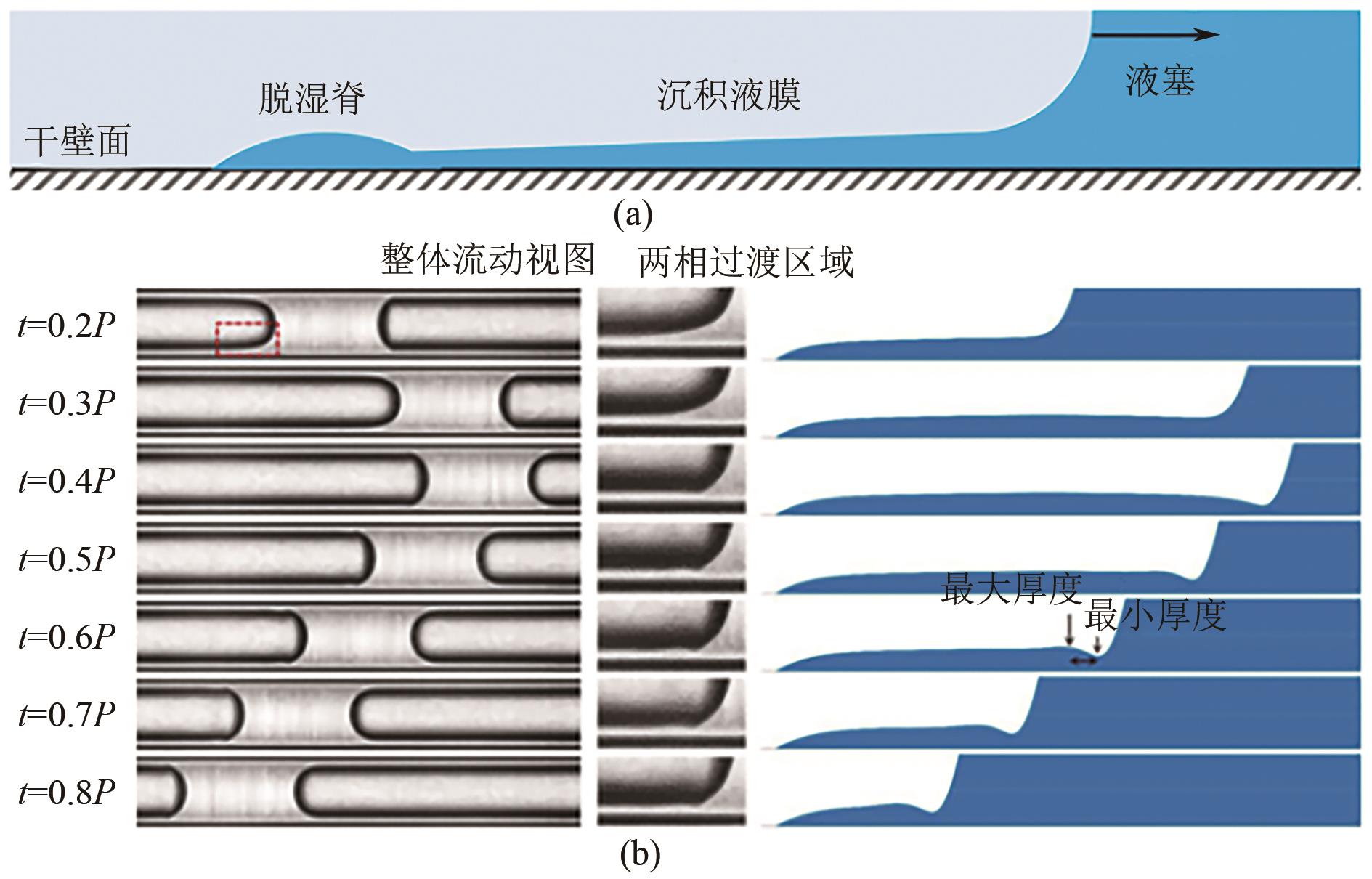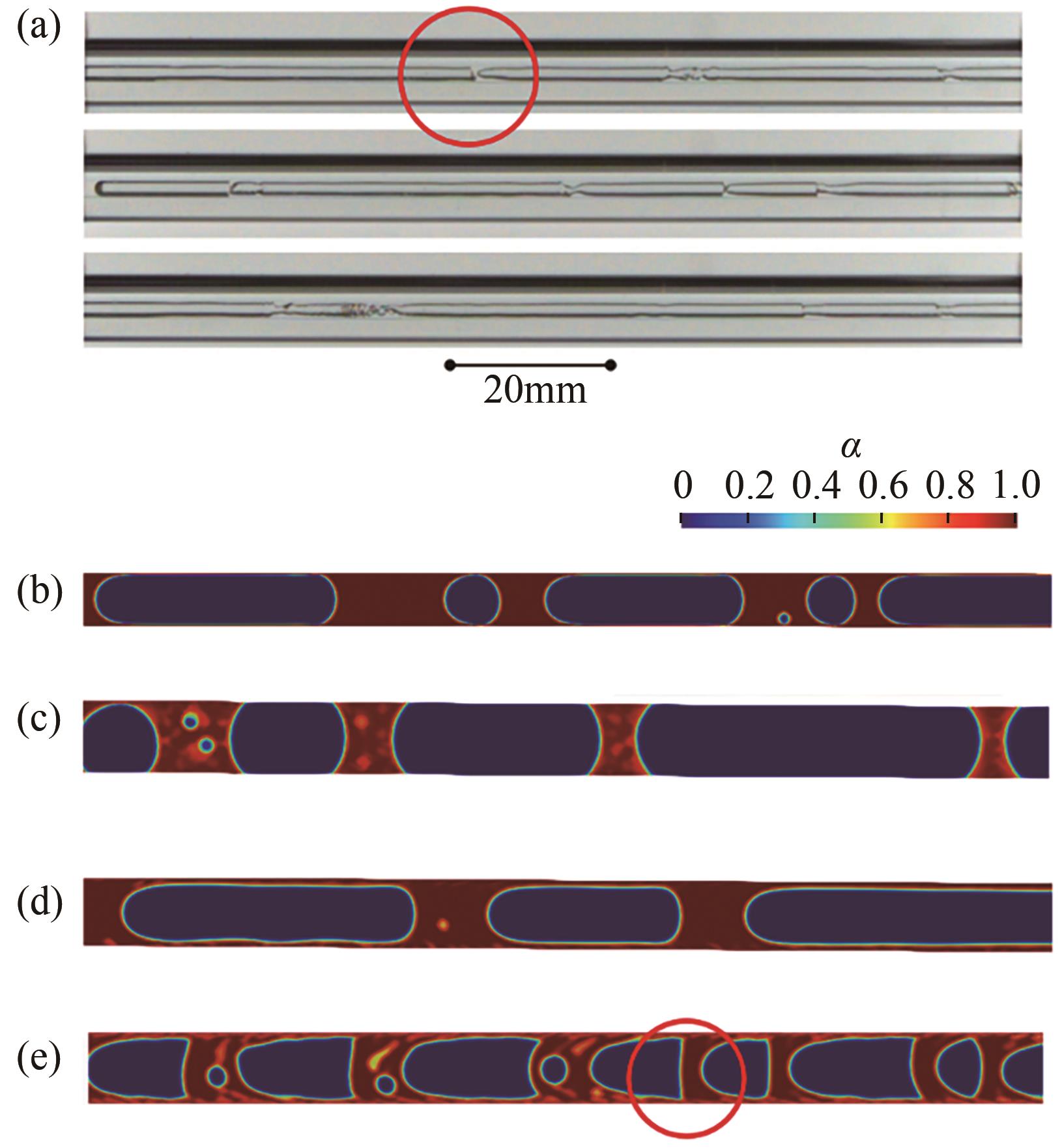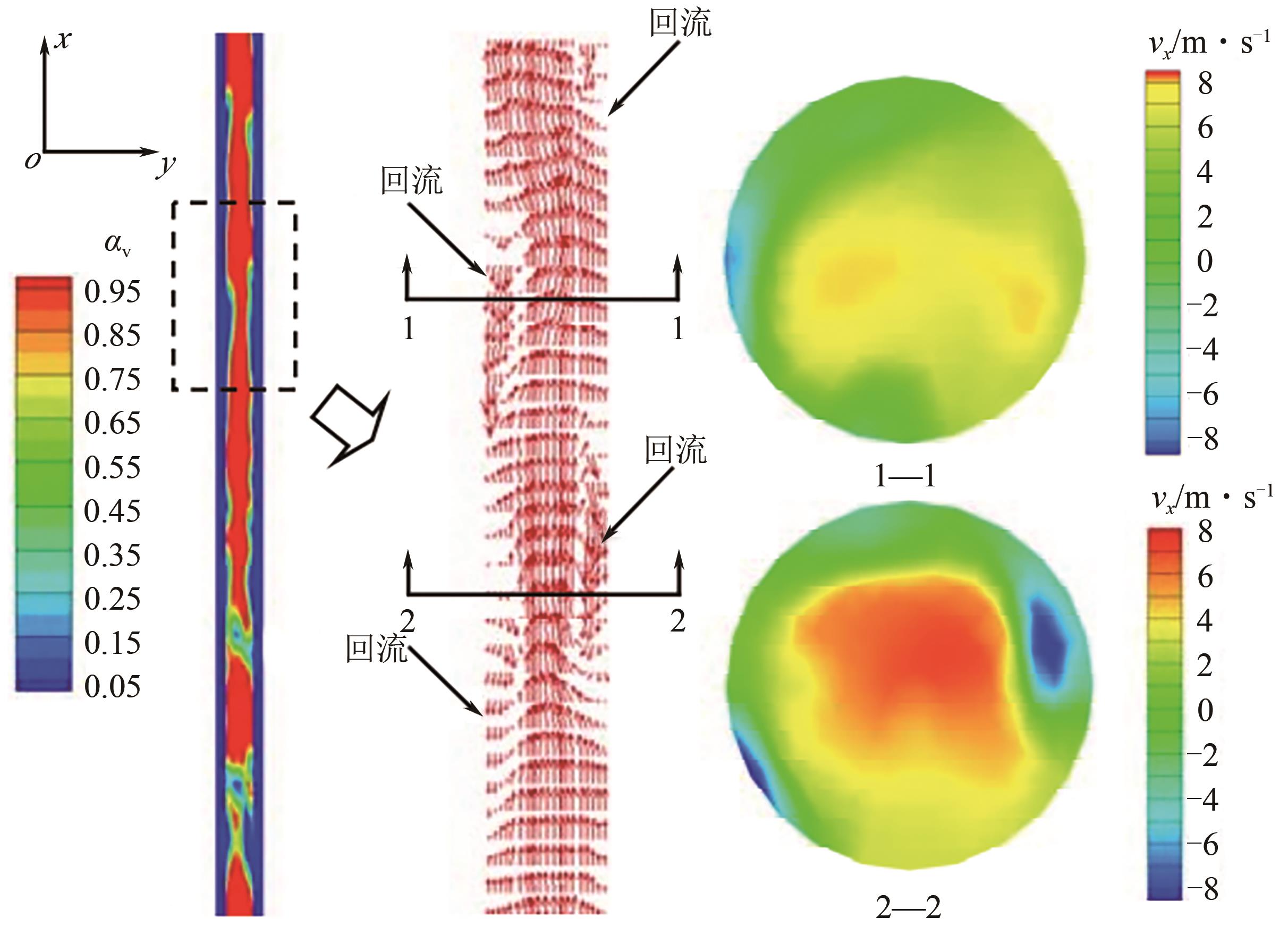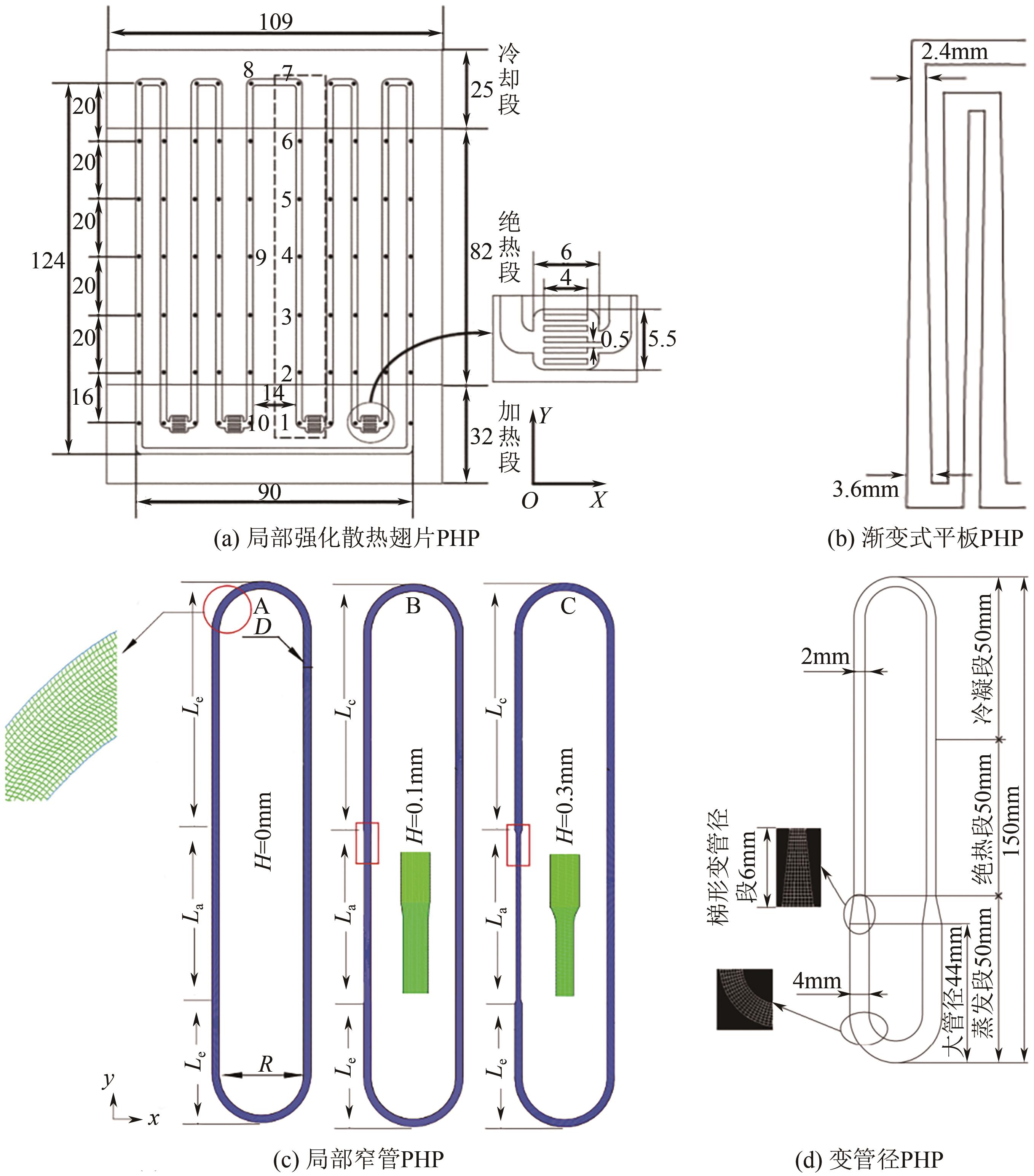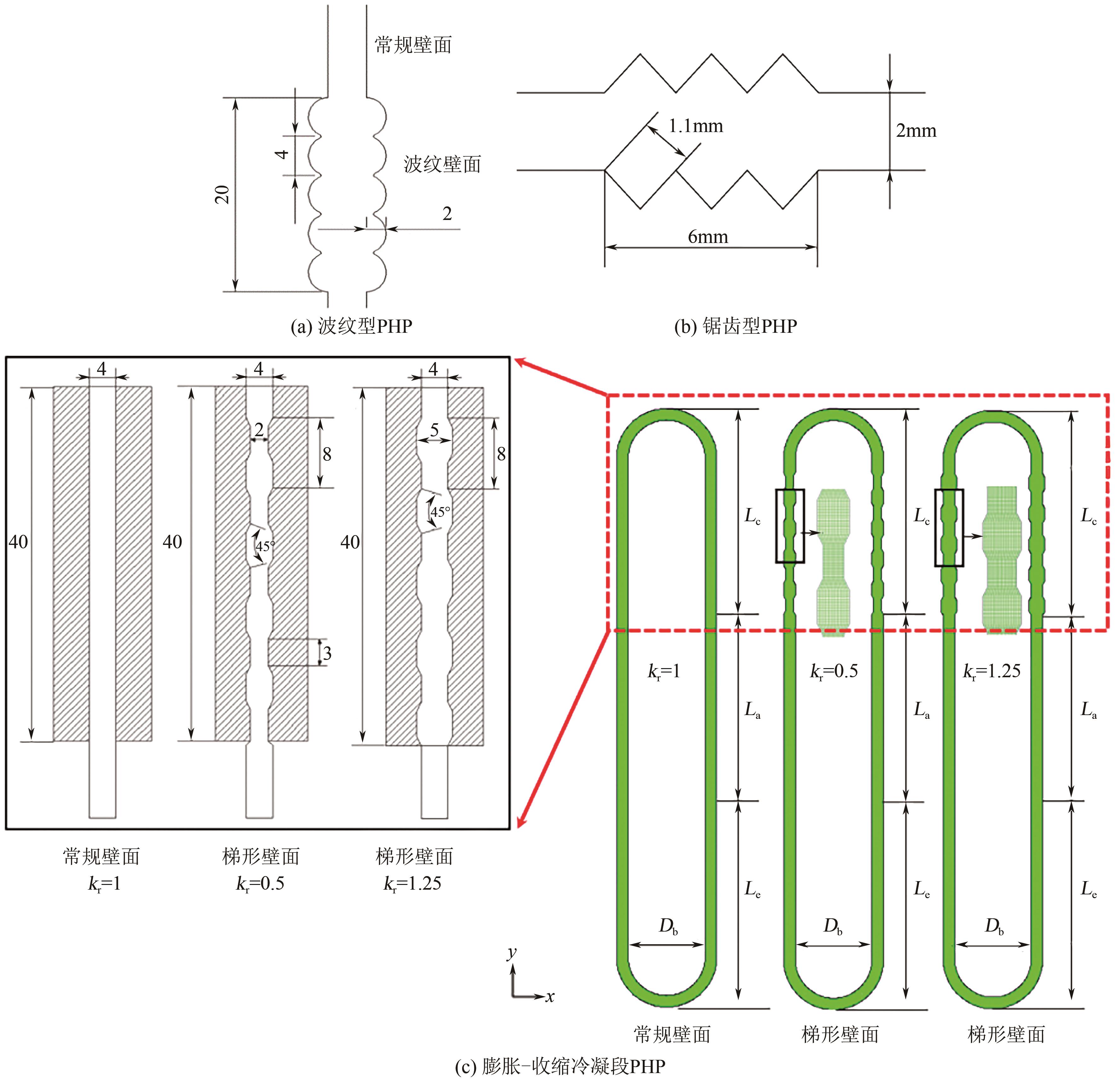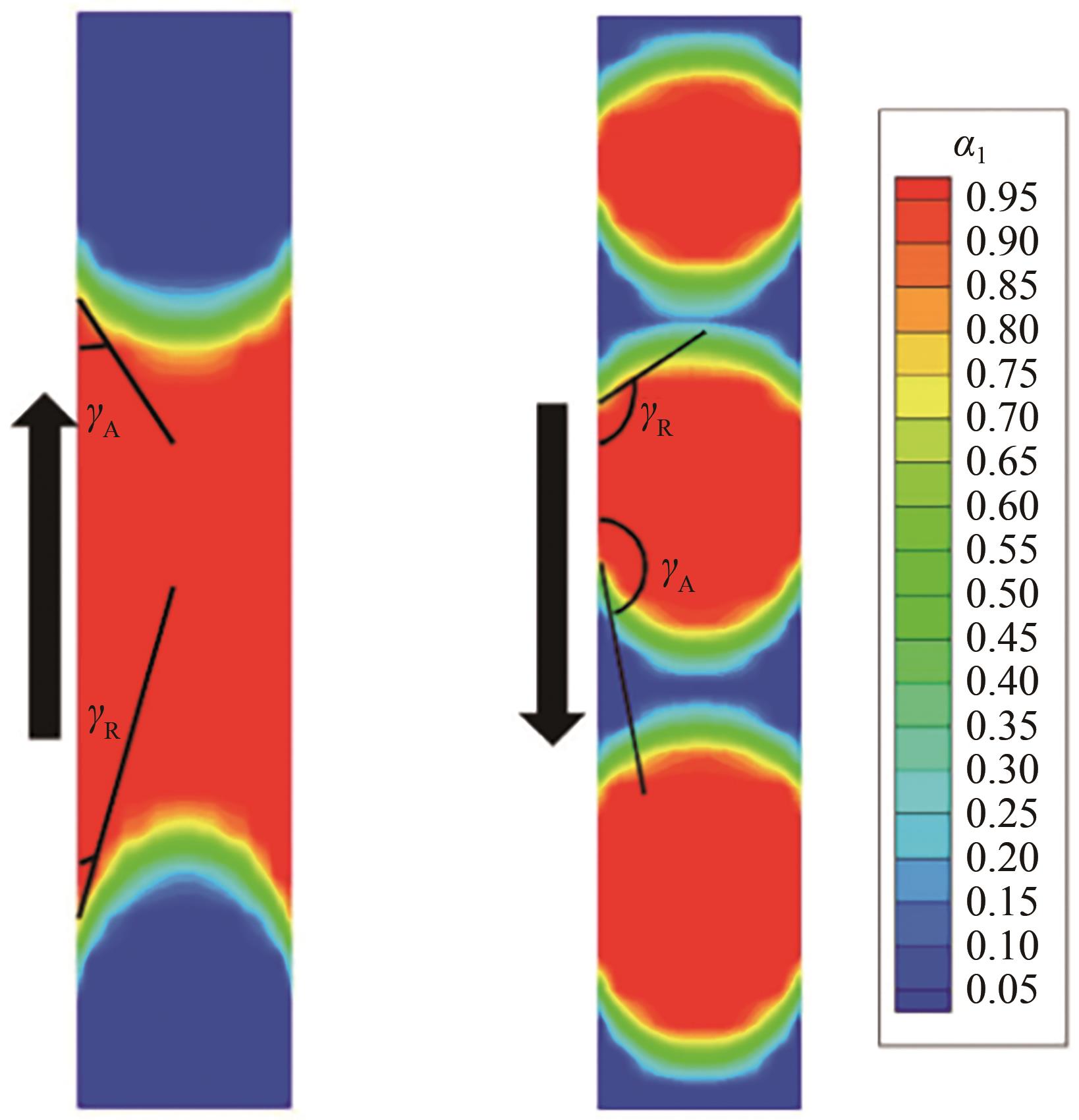Chemical Industry and Engineering Progress ›› 2023, Vol. 42 ›› Issue (8): 4167-4181.DOI: 10.16085/j.issn.1000-6613.2022-1771
• Chemical processes and equipment • Previous Articles Next Articles
Review on computational fluid dynamics (CFD) simulation and advances in pulsating heat pipes
BU Zhicheng( ), JIAO Bo(
), JIAO Bo( ), LIN Haihua, SUN Hongyuan
), LIN Haihua, SUN Hongyuan
- Naval Architecture and Port Engineering College, Shandong Jiaotong University, Weihai 264200, Shandong, China
-
Received:2022-09-22Revised:2023-01-15Online:2023-09-19Published:2023-08-15 -
Contact:JIAO Bo
脉动热管计算流体力学模型与研究进展
- 山东交通学院船舶与港口工程学院,山东 威海 264200
-
通讯作者:焦波 -
作者简介:卜治丞(2000—),男,硕士研究生,研究方向为脉动热管强化传热。E-mail:21226020@stu.sdjtu.edu.cn。 -
基金资助:山东交通学院博士科研启动基金(BS2020032);山东交通学院科研基金(Z202124);山东交通学院研究生科技创新项目(2022YK100)
CLC Number:
Cite this article
BU Zhicheng, JIAO Bo, LIN Haihua, SUN Hongyuan. Review on computational fluid dynamics (CFD) simulation and advances in pulsating heat pipes[J]. Chemical Industry and Engineering Progress, 2023, 42(8): 4167-4181.
卜治丞, 焦波, 林海花, 孙洪源. 脉动热管计算流体力学模型与研究进展[J]. 化工进展, 2023, 42(8): 4167-4181.
share this article
Add to citation manager EndNote|Ris|BibTeX
URL: https://hgjz.cip.com.cn/EN/10.16085/j.issn.1000-6613.2022-1771
| 年份 | 几何 | 两相流模型 | 相变模型 | 黏性模型 | 内径 | 弯折数 | 工质 | 倾角 | 充液率 | 蒸发段边界条件 | 验证 |
|---|---|---|---|---|---|---|---|---|---|---|---|
| 2009[ | 3D | VOF | Lee(βv=βc =10) | k-ε | 1.5mm | 3 | 去离子水 | 90° | 0.645 | 80W, 100W, 120W | & |
| 2015[ | 2D | VOF | Lee(βv=βc =0.1) | k-ε | 2mm | 1 | 水 | 90° | 0.4, 0.5, 0.6 | 10~40W | & |
| 2016[ | 2D | VOF | Lee (βv=βc=0.1) | k-ε | 3.8mm | 1 | 去离子水 | 90° | 0.3~0.6 | 5~40W | * |
| 2016[ | 2D | VOF | Lee(βv=βc=0.1) | — | 2mm | 5 | R508B | 90° | 0.3, 0.5, 0.7 | 20~120W | — |
| 2018[ | 3D | VOF | Lee(βv=βc=0.1) | k-ε | 2mm | 1 | 去离子水 | Le、Lc:θ=0°,La:θ=5~45° | 0.5 | 10~40W | — |
| 2018[ | 3D | VOF | Lee(βv=0.1, βc =1) | Standard k-ε | 2mm | 4 | CTAC 水溶液 | 90° | 0.35, 0.5, 0.65 | 20~50W | — |
| 2019[ | 3D | VOF | Lee (βv=βc=0.1) | k-ε | 4mm | 1 | CTAC 水溶液 | 90° | — | 10~40W | — |
| 2019[ | 2D | VOF | Lee (βv=βc=0.1) | — | 1.5mm | 1 | MEPCM悬浮液 | 90° | 0.6 | 60W, 80W, 100W | & |
| 2020[ | 2D | VOF | Lee(βv=βc=0.1) | Laminar | 2mm | 3 | 液氮 | — | 0.5, 0.6, 0.7 | 85~110K | — |
| 2020[ | 2D | VOF | Lee(βv=βc=0.1) | RNG k-ε | 3mm | 1 | 去离子水 | 90° | 0.5 | 18~97.11W | & |
| 2020[ | 3D | VOF | Lee (βv=βc=0.1) | k-ε | 4mm | 1 | 去离子水 | 90° | 0.5 | 10~40W | — |
| 2020[ | 2D | VOF | Lee(βv=5, βc =500) | Laminar | 2.3mm | 1 | 液氢 | 90° | 0.8 | 0.27~1W | & |
| 2021[ | 3D | VOF | Lee(βv=βc·ρl /ρv) | — | 2mm | 7, 16, 23 | 水 | 90° | 0.5 | 353.15K | & |
| 2012[ | 3D | VOF | Lee | k-ε | 2mm×2mm 矩形通道 | 5 | 水 | 90° | 0.3~0.7 | 80~140W | — |
| 2013[ | 2D | Mixture/VOF | Lee | Laminar | 0.5mm, 0.8mm,1.3mm, 1.8mm | 4 | 水 | 90° | 0.5 | 8~72W | * |
| 2015[ | 2D | VOF | Lee | — | 0.5mm | 3 | 液氦 | 90° | 0.5 | 0.2W | — |
| 2016[ | 3D | VOF | Lee | — | 2mm | 1 | 水、甲醇、乙醇 | 90° | 0.6 | 20W, 40W, 60W | * |
| 2018[ | 2D | VOF | Lee | — | 0.5mm | 6 | 液氮 | 0~90° | 0.3~0.7 | 25~325W | — |
| 2019[ | 2D | VOF | Lee | Realizable k-ε | 2mm | 2 | 水 | 90° | 0.5 | 5×104W/m2 | — |
| 2019[ | 2D | VOF | Lee | — | 0.5mm×2mm 矩形通道 | 6 | 银纳米流体 | 90° | 0.3~0.7 | 20~120W | — |
| 2020[ | 3D | VOF | Lee | Realizable k-ε | 1.85mm | 8 | R123 | 90° | 0.5, 0.6 | 323.15K | * |
| 2021[ | 2D | VOF | Lee | Realizable k-ε | 2mm | 2 | 水 | 90° | 0.5 | 15W | * |
| 2021[ | 3D | Mixture | Lee | Standard k-ε | — | — | 水 | — | 0.5 | (5×103~1.5×104 )W/m2 | — |
| 2014[ | 3D | VOF | — | Laminar | 2mm | 2 | 水、甲醇、乙醇、丙酮、 水-甲醇、水-乙醇、水-丙酮 | 90° | 0.5 | 8~80W | * |
| 2016[ | 3D | VOF | — | Laminar | 1.8mm | 5 | 水、乙醇 | — | 0.35~0.75 | 10~120W | & |
| 2016[ | 2D | VOF | — | k-ε | 3mm | 1 | 水 | 90° | 0.6 | 250W | * |
| 2017[ | 3D | VOF | — | k-ε | 2mm, 3mm | 2 | 甲醇、水-甲醇、水-乙醇 | — | 0.5 | 10~70W | — |
| 2021[ | 2D | VOF | — | Laminar | 2mm | 1 | 水 | 90° | 0.6 | 3~9W | — |
| 2021[ | 3D | VOF | — | — | 2mm | 1 | 乙烷 | 90° | 0.3 | 5~50W | — |
| 2017[ | 3D | VOF | Hu (η=0.005) | — | 1mm×1mm 矩形通道 | 1 | R245fa | 90° | 0.7, 0.8 | 9~21W | * |
| 2018[ | 2D | VOF | Hu | Realizable k-ε | 3mm×1.7mm 矩形通道 | 6 | 水 | 90° | 0.4~0.7 | 5000~31300W/m2 | & |
| 2018[ | 2D | VOF | Hu | Realizable k-ε | 2mm | 1 | 水 | 45°、90° | 0.4~0.7 | 20~80W | & |
| 2020[ | 2D | VOF | Kafeel(βv=βc =0.1) | — | 2mm | 5, 10, 15, 20 | 乙醇 | 0°, 90° | 0.5 | 1000W/m2 | & |
| 2020[ | 2D | VOF | Xu | k-ε | 4mm | 1 | 去离子水 | 90° | 0.4, 0.6 | 18~86.6W | & |
| 2021[ | 2D | VOF | Lee(βv=0.5, βc=100) Kafeel(βv=0.5, βc=100) Xu (βv=0.1, βc =0.1) Tanasawa (η=1) | k-ω | 1.5mm | 2 | 乙醇 | 90° | 0.526 | 75W, 100W | * |
| 年份 | 几何 | 两相流模型 | 相变模型 | 黏性模型 | 内径 | 弯折数 | 工质 | 倾角 | 充液率 | 蒸发段边界条件 | 验证 |
|---|---|---|---|---|---|---|---|---|---|---|---|
| 2009[ | 3D | VOF | Lee(βv=βc =10) | k-ε | 1.5mm | 3 | 去离子水 | 90° | 0.645 | 80W, 100W, 120W | & |
| 2015[ | 2D | VOF | Lee(βv=βc =0.1) | k-ε | 2mm | 1 | 水 | 90° | 0.4, 0.5, 0.6 | 10~40W | & |
| 2016[ | 2D | VOF | Lee (βv=βc=0.1) | k-ε | 3.8mm | 1 | 去离子水 | 90° | 0.3~0.6 | 5~40W | * |
| 2016[ | 2D | VOF | Lee(βv=βc=0.1) | — | 2mm | 5 | R508B | 90° | 0.3, 0.5, 0.7 | 20~120W | — |
| 2018[ | 3D | VOF | Lee(βv=βc=0.1) | k-ε | 2mm | 1 | 去离子水 | Le、Lc:θ=0°,La:θ=5~45° | 0.5 | 10~40W | — |
| 2018[ | 3D | VOF | Lee(βv=0.1, βc =1) | Standard k-ε | 2mm | 4 | CTAC 水溶液 | 90° | 0.35, 0.5, 0.65 | 20~50W | — |
| 2019[ | 3D | VOF | Lee (βv=βc=0.1) | k-ε | 4mm | 1 | CTAC 水溶液 | 90° | — | 10~40W | — |
| 2019[ | 2D | VOF | Lee (βv=βc=0.1) | — | 1.5mm | 1 | MEPCM悬浮液 | 90° | 0.6 | 60W, 80W, 100W | & |
| 2020[ | 2D | VOF | Lee(βv=βc=0.1) | Laminar | 2mm | 3 | 液氮 | — | 0.5, 0.6, 0.7 | 85~110K | — |
| 2020[ | 2D | VOF | Lee(βv=βc=0.1) | RNG k-ε | 3mm | 1 | 去离子水 | 90° | 0.5 | 18~97.11W | & |
| 2020[ | 3D | VOF | Lee (βv=βc=0.1) | k-ε | 4mm | 1 | 去离子水 | 90° | 0.5 | 10~40W | — |
| 2020[ | 2D | VOF | Lee(βv=5, βc =500) | Laminar | 2.3mm | 1 | 液氢 | 90° | 0.8 | 0.27~1W | & |
| 2021[ | 3D | VOF | Lee(βv=βc·ρl /ρv) | — | 2mm | 7, 16, 23 | 水 | 90° | 0.5 | 353.15K | & |
| 2012[ | 3D | VOF | Lee | k-ε | 2mm×2mm 矩形通道 | 5 | 水 | 90° | 0.3~0.7 | 80~140W | — |
| 2013[ | 2D | Mixture/VOF | Lee | Laminar | 0.5mm, 0.8mm,1.3mm, 1.8mm | 4 | 水 | 90° | 0.5 | 8~72W | * |
| 2015[ | 2D | VOF | Lee | — | 0.5mm | 3 | 液氦 | 90° | 0.5 | 0.2W | — |
| 2016[ | 3D | VOF | Lee | — | 2mm | 1 | 水、甲醇、乙醇 | 90° | 0.6 | 20W, 40W, 60W | * |
| 2018[ | 2D | VOF | Lee | — | 0.5mm | 6 | 液氮 | 0~90° | 0.3~0.7 | 25~325W | — |
| 2019[ | 2D | VOF | Lee | Realizable k-ε | 2mm | 2 | 水 | 90° | 0.5 | 5×104W/m2 | — |
| 2019[ | 2D | VOF | Lee | — | 0.5mm×2mm 矩形通道 | 6 | 银纳米流体 | 90° | 0.3~0.7 | 20~120W | — |
| 2020[ | 3D | VOF | Lee | Realizable k-ε | 1.85mm | 8 | R123 | 90° | 0.5, 0.6 | 323.15K | * |
| 2021[ | 2D | VOF | Lee | Realizable k-ε | 2mm | 2 | 水 | 90° | 0.5 | 15W | * |
| 2021[ | 3D | Mixture | Lee | Standard k-ε | — | — | 水 | — | 0.5 | (5×103~1.5×104 )W/m2 | — |
| 2014[ | 3D | VOF | — | Laminar | 2mm | 2 | 水、甲醇、乙醇、丙酮、 水-甲醇、水-乙醇、水-丙酮 | 90° | 0.5 | 8~80W | * |
| 2016[ | 3D | VOF | — | Laminar | 1.8mm | 5 | 水、乙醇 | — | 0.35~0.75 | 10~120W | & |
| 2016[ | 2D | VOF | — | k-ε | 3mm | 1 | 水 | 90° | 0.6 | 250W | * |
| 2017[ | 3D | VOF | — | k-ε | 2mm, 3mm | 2 | 甲醇、水-甲醇、水-乙醇 | — | 0.5 | 10~70W | — |
| 2021[ | 2D | VOF | — | Laminar | 2mm | 1 | 水 | 90° | 0.6 | 3~9W | — |
| 2021[ | 3D | VOF | — | — | 2mm | 1 | 乙烷 | 90° | 0.3 | 5~50W | — |
| 2017[ | 3D | VOF | Hu (η=0.005) | — | 1mm×1mm 矩形通道 | 1 | R245fa | 90° | 0.7, 0.8 | 9~21W | * |
| 2018[ | 2D | VOF | Hu | Realizable k-ε | 3mm×1.7mm 矩形通道 | 6 | 水 | 90° | 0.4~0.7 | 5000~31300W/m2 | & |
| 2018[ | 2D | VOF | Hu | Realizable k-ε | 2mm | 1 | 水 | 45°、90° | 0.4~0.7 | 20~80W | & |
| 2020[ | 2D | VOF | Kafeel(βv=βc =0.1) | — | 2mm | 5, 10, 15, 20 | 乙醇 | 0°, 90° | 0.5 | 1000W/m2 | & |
| 2020[ | 2D | VOF | Xu | k-ε | 4mm | 1 | 去离子水 | 90° | 0.4, 0.6 | 18~86.6W | & |
| 2021[ | 2D | VOF | Lee(βv=0.5, βc=100) Kafeel(βv=0.5, βc=100) Xu (βv=0.1, βc =0.1) Tanasawa (η=1) | k-ω | 1.5mm | 2 | 乙醇 | 90° | 0.526 | 75W, 100W | * |
| 项目 | Lee模型[ | Tanasawa模型[ | 薄液膜改进模型[ |
|---|---|---|---|
| 内容 | 界面面积密度: 令 | 界面面积密度: 认为气体密度相对于液体密度可以忽略: | 界面面积密度: |
源项 公式 | Kafeel优化[ Xu优化[ | 假设贴壁网格 Δx为贴壁网格垂直壁面方向的高度。 薄液膜处蒸发: 薄液膜处冷凝: |
| 项目 | Lee模型[ | Tanasawa模型[ | 薄液膜改进模型[ |
|---|---|---|---|
| 内容 | 界面面积密度: 令 | 界面面积密度: 认为气体密度相对于液体密度可以忽略: | 界面面积密度: |
源项 公式 | Kafeel优化[ Xu优化[ | 假设贴壁网格 Δx为贴壁网格垂直壁面方向的高度。 薄液膜处蒸发: 薄液膜处冷凝: |
| 模型 | 二维 | 三维 |
|---|---|---|
弯液面区域工质 受力示意图 |  |  |
| 重力 | ||
| 表面张力 | ||
| 重力/表面张力 | ||
| 相似原理分析 | 保持二者G/Fs比例相同,σ相同时⇒ | |
| 模型 | 二维 | 三维 |
|---|---|---|
弯液面区域工质 受力示意图 |  |  |
| 重力 | ||
| 表面张力 | ||
| 重力/表面张力 | ||
| 相似原理分析 | 保持二者G/Fs比例相同,σ相同时⇒ | |
| 1 | AKACHI Hisateru. Structure of a heat pipe: US4921041[P]. 1990-05-01. |
| 2 | 屈健. 脉动热管技术研究及应用进展[J]. 化工进展, 2013, 32(1): 33-41. |
| QU Jian. Oscillating heat pipes: State of the art and applications[J]. Chemical Industry and Engineering Progress, 2013, 32(1): 33-41. | |
| 3 | 权力. 板式脉动热管传热特性实验研究[D]. 北京: 北京交通大学, 2009. |
| QUAN Li. Experimental study on heat transfer characteristic of plate pulsating heat pipe[D]. Beijing: Beijing Jiaotong University, 2009. | |
| 4 | HAN Xiaohong, WANG Xuehui, ZHENG Haoce, et al. Review of the development of pulsating heat pipe for heat dissipation[J]. Renewable and Sustainable Energy Reviews, 2016, 59: 692-709. |
| 5 | KHANDEKAR Sameer, GROLL Manfred. An insight into thermo-hydrodynamic coupling in closed loop pulsating heat pipes[J]. International Journal of Thermal Sciences, 2004, 43(1): 13-20. |
| 6 | DAVE Chirag, DANDALE Prajwal, SHRIVASTAVA Kushagra, et al. A review on pulsating heat pipes: Latest research, applications and future scope[J]. Journal of Thermal Engineering, 2021, 7(3): 387-408. |
| 7 | SHAFII Mohammad B, FAGHRI Amir, ZHANG Yuwen. Thermal modeling of unlooped and looped pulsating heat pipes[J]. Journal of Heat Transfer, 2001, 123(6): 1159-1172. |
| 8 | SENJAYA Raffles, INOUE Takayoshi. Oscillating heat pipe simulation considering dryout phenomena[J]. Heat and Mass Transfer, 2014, 50(10): 1429-1441. |
| 9 | Joohan BAE, LEE Sang yong, KIM Sung Jin. Numerical investigation of effect of film dynamics on fluid motion and thermal performance in pulsating heat pipes[J]. Energy Conversion and Management, 2017, 151: 296-310. |
| 10 | MAMELI Mauro, BESAGNI Giorgio, BANSAL Pradeep K, et al. Innovations in pulsating heat pipes: From origins to future perspectives[J]. Applied Thermal Engineering, 2022, 203: 117921. |
| 11 | LIU X D, HAO Y L. Numerical simulation of vapor-liquid two-phase flow in a closed loop oscillating heat pipe[C]//Florida: Proceedings of ASME 2009 International Mechanical Engineering Congress and Exposition, 2010: 609-617. |
| 12 | AYEL Vincent, SLOBODENIUK Maksym, BERTOSSI Rémi, et al. Flat plate pulsating heat pipes: A review on the thermohydraulic principles, thermal performances and open issues[J]. Applied Thermal Engineering, 2021, 197: 117200. |
| 13 | KIM Wookyoung, KIM Sung Jin. Fundamental issues and technical problems about pulsating heat pipes[J]. Journal of Heat Transfer, 2021, 143(10): 100803. |
| 14 | XU Yanyan, XUE Yanqin, QI Hong, et al. An updated review on working fluids, operation mechanisms, and applications of pulsating heat pipes[J]. Renewable and Sustainable Energy Reviews, 2021, 144: 110995. |
| 15 | WANG Jiansheng, MA He, ZHU Qiang. Effects of the evaporator and condenser length on the performance of pulsating heat pipes[J]. Applied Thermal Engineering, 2015, 91: 1018-1025. |
| 16 | WANG Jiansheng, MA He, ZHU Qiang, et al. Numerical and experimental investigation of pulsating heat pipes with corrugated configuration[J]. Applied Thermal Engineering, 2016, 102: 158-166. |
| 17 | 马文统, 陈曦, 曹广亮, 等. 中低温脉动热管传热性能的模拟研究[J]. 真空与低温, 2016, 22(5): 282-285, 300. |
| MA Wentong, CHEN Xi, CAO Guangliang, et al. Numerical simulation study of the heat-transfer preformance of pulsating heat pipe at medium and low temperature[J]. Vacuum and Cryogenics, 2016, 22(5): 282-285, 300. | |
| 18 | WANG Jiansheng, BAI Xueyu. The features of CLPHP with partial horizontal structure[J]. Applied Thermal Engineering, 2018, 133: 682-689. |
| 19 | BASTAKOTI DURGA, ZHANG H N, CAI W H, et al. Numerical analysis of effects of surface tension and viscosity on 3 dimensional pulsating heat pipe[C]. Montreal: Proceedings of ASME 2018 5th Joint US-European Fluids Engineering Division Summer Meeting, 2018. |
| 20 | WANG Jiansheng, XIE Jinyuan, LIU Xueling. Investigation on the performance of closed-loop pulsating heat pipe with surfactant[J]. Applied Thermal Engineering, 2019, 160: 113998. |
| 21 | LI Qingfeng, WANG Yanan, LIAN Chen, et al. Effect of micro encapsulated phase change material on the anti-dry-out ability of pulsating heat pipes[J]. Applied Thermal Engineering, 2019, 159: 113854. |
| 22 | SAGAR Kalpak R, NAIK H B, MEHTA Hemantkumar B. CFD analysis of cryogenic pulsating heat pipe with near critical diameter under varying gravity conditions[J]. Theoretical Foundations of Chemical Engineering, 2020, 54(1): 64-76. |
| 23 | XIE Fubo, LI Xinlong, QIAN Peng, et al. Effects of geometry and multisource heat input on flow and heat transfer in single closed-loop pulsating heat pipe[J]. Applied Thermal Engineering, 2020, 168: 114856. |
| 24 | WANG Jiansheng, XIE Jinyuan, LIU Xueling. Investigation of wettability on performance of pulsating heat pipe[J]. International Journal of Heat and Mass Transfer, 2020, 150: 119354. |
| 25 | 徐金柱, 焦波, 孙潇, 等. 单环路液氢温区脉动热管高充液率工况计算流体动力学(CFD)模拟[J]. 化工进展, 2020, 39(7): 2556-2565. |
| XU Jinzhu, JIAO Bo, SUN Xiao, et al. CFD simulation on hydrogen pulsating heat pipe with single turn and a high filling ratio[J]. Chemical Industry and Engineering Progress, 2020, 39(7): 2556-2565. | |
| 26 | MUCCI Alberto, KHOLI Foster Kwame, Jason CHETWYND-CHATWIN, et al. Numerical investigation of flow instability and heat transfer characteristics inside pulsating heat pipes with different numbers of turns[J]. International Journal of Heat and Mass Transfer, 2021, 169: 120934. |
| 27 | XU Dehao, CHEN Taofei, XUAN Yimin. Thermo-hydrodynamics analysis of vapor-liquid two-phase flow in the flat-plate pulsating heat pipe[J]. International Communications in Heat and Mass Transfer, 2012, 39(4): 504-508. |
| 28 | LIN Zirong, WANG Shuangfeng, SHIRAKASHI Ryo, et al. Simulation of a miniature oscillating heat pipe in bottom heating mode using CFD with unsteady modeling[J]. International Journal of Heat and Mass Transfer, 2013, 57(2): 642-656. |
| 29 | 唐恺, 陈曦. 低温脉动热管气液两相流数值模拟[J]. 能源工程, 2015(4): 4-8. |
| TANG Kai, CHEN Xi. Numerical simulation of vapor-liquid two-phase flow in a cryogenic pulsating heat pipe[J]. Energy Engineering, 2015(4): 4-8. | |
| 30 | YEBOAH Siegfried K, DARKWA Jo. Investigations into the thermal performance of a helically coiled closed loop oscillating heat pipe[C]. Virginia: 14th International Energy Conversion Engineering Conference, 2016: 4794. |
| 31 | 邵帅, 陈曦, 唐恺, 等. 低温脉动热管传热特性的数值模拟研究[J]. 真空与低温, 2018, 24(1): 48-53. |
| SHAO Shuai, CHEN Xi, TANG Kai, et al. Numerical simulation study on heat transfer characteristics of cryogenic pulsating heat pipe[J]. Vacuum and Cryogenics, 2018, 24(1): 48-53. | |
| 32 | 蒋二辉, 张东伟, 周俊杰, 等. 不同结构下两弯头脉动热管的数值模拟[J]. 化工学报, 2019, 70(S2): 244-249. |
| JIANG Erhui, ZHANG Dongwei, ZHOU Junjie, et al. Numerical simulation of pulsating heat pipes with two-bends in different structures[J]. CIESC Journal, 2019, 70(S2): 244-249. | |
| 33 | XU Hui, ZHANG Ping, YAN Lipei, et al. Thermal characteristic and analysis of microchannel structure flat plate pulsating heat pipe with silver nanofluid[J]. IEEE Access, 2019, 7: 51724-51734. |
| 34 | Duy-Tan VO, KIM Hyoung-Tak, Junghyuk KO, et al. An experiment and three-dimensional numerical simulation of pulsating heat pipes[J]. International Journal of Heat and Mass Transfer, 2020, 150: 119317. |
| 35 | ZHANG Dongwei, JIANG Erhui, SHEN Chao, et al. Numerical simulation on pulsating heat pipe with connected-path structure[J]. Journal of Enhanced Heat Transfer, 2021, 28(2): 1-17. |
| 36 | WEI Zhikang, HOU Yan, DUAN Yanjun, et al. Numerical investigation on the thermal performance of three advanced micro heat pipes[J]. Heat Transfer Engineering, 2022, 43(14): 1193-1205. |
| 37 | PACHGHARE Pramod R, MAHALLE Ashish M. Thermo-hydrodynamics of closed loop pulsating heat pipe: An experimental study[J]. Journal of Mechanical Science and Technology, 2014, 28(8): 3387-3394. |
| 38 | POURYOUSSEFI S M, ZHANG Yuwen. Nonlinear analysis of chaotic flow in a three-dimensional closed-loop pulsating heat pipe[J]. Journal of Heat Transfer, 2016, 138(12): 122003. |
| 39 | Jiaqiang E, ZHAO Xiaohuan, LIU Haili, et al. Field synergy analysis for enhancing heat transfer capability of a novel narrow-tube closed oscillating heat pipe[J]. Applied Energy, 2016, 175: 218-228. |
| 40 | VENKATA SURESH J, BHRAMARA P. CFD analysis of multi turn pulsating heat pipe[J]. Materials Today: Proceedings, 2017, 4(2): 2701-2710. |
| 41 | 战洪仁, 于胜利, 王立鹏, 等. 亲水表面单环脉动热管的传热性能研究[J]. 化学工程, 2021, 49(11): 37-41, 78. |
| ZHAN Hongren, YU Shengli, WANG Lipeng, et al. Heat transfer performance of single loop pulsating heat pipe on hydrophilic surface[J]. Chemical Engineering (China), 2021, 49(11): 37-41, 78. | |
| 42 | 陈贝贝, 陈曦, 邵帅, 等. 乙烷脉动热管的CFD数值模拟研究及实验对比[J]. 真空与低温, 2021, 27(1): 68-72. |
| CHEN Beibei, CHEN Xi, SHAO Shuai, et al. CFD numerical simulation research and experimental comparison of an ethane pulsating heat pipe[J]. Vacuum and Cryogenics, 2021, 27(1): 68-72. | |
| 43 | 胡伟男, 周春鹏, 崔付龙, 等. 单环路平板脉动热管定向循环的数值研究[J]. 低温与超导, 2017, 45(2): 27-34. |
| HU Weinan, ZHOU Chunpeng, CUI Fulong, et al. Numerical simulation of a single-loop flat plate pulsating heat pipe under unidirectional flow condition[J]. Cryogenics & Superconductivity, 2017, 45(2): 27-34. | |
| 44 | 王迅, 王盼, 刘梦阳, 等. 渐变式截面平板脉动热管的数值模拟及分析[J]. 化学工程, 2018, 46(7): 7-11. |
| WANG Xun, WANG Pan, LIU Mengyang, et al. Numerical simulation and analysis of flat pulsating heat pipe with gradient section[J]. Chemical Engineering (China), 2018, 46(7): 7-11. | |
| 45 | 王迅, 刘梦阳, 王盼, 等. 变管径单回路脉动热管传热特性数值研究[J]. 化学工程, 2018, 46(9): 32-36. |
| WANG Xun, LIU Mengyang, WANG Pan, et al. Numerical simulation on heat transfer characteristics of a single-loop pulsating heat pipe with variable diameters[J]. Chemical Engineering (China), 2018, 46(9): 32-36. | |
| 46 | CHOI Jongwook, ZHANG Yuwen. Numerical simulation of oscillatory flow and heat transfer in pulsating heat pipes with multi-turns using OpenFOAM[J]. Numerical Heat Transfer, Part A: Applications, 2020, 77(8): 761-781. |
| 47 | WANG Weiwei, WANG Lei, CAI Yang, et al. Thermo-hydrodynamic model and parametric optimization of a novel miniature closed oscillating heat pipe with periodic expansion-constriction condensers[J]. International Journal of Heat and Mass Transfer, 2020, 152: 119460. |
| 48 | Przemysław BŁASIAK, OPALSKI Marcin, PARMAR Parthkumar, et al. The thermal—Flow processes and flow pattern in a pulsating heat pipe—Numerical modelling and experimental validation[J]. Energies, 2021, 14(18): 5952. |
| 49 | KREUTZER Michiel T, KAPTEIJN Freek, MOULIJN Jacob A, et al. Inertial and interfacial effects on pressure drop of Taylor flow in capillaries[J]. AIChE Journal, 2005, 51(9): 2428-2440. |
| 50 | Hyung Yun NOH, KIM Sung Jin. Thermal characterization and optimization of pulsating heat pipes operating in a circulation mode[J]. International Journal of Heat and Mass Transfer, 2017, 115: 1234-1246. |
| 51 | Soohwan JUN, KIM Sung Jin. Experimental investigation on the thermodynamic state of vapor plugs in pulsating heat pipes[J]. International Journal of Heat and Mass Transfer, 2019, 134: 321-328. |
| 52 | Jaeyeong JO, KIM Jungho, KIM Sung Jin. Experimental investigations of heat transfer mechanisms of a pulsating heat pipe[J]. Energy Conversion and Management, 2019, 181: 331-341. |
| 53 | FOURGEAUD L, ERCOLANI E, DUPLAT J, et al. 3D reconstruction of dynamic liquid film shape by optical grid deflection method[J]. The European Physical Journal E, 2018, 41(1): 5. |
| 54 | FOURGEAUD Laura, NIKOLAYEV Vadim S, ERCOLANI Eric, et al. In situ investigation of liquid films in pulsating heat pipe[J]. Applied Thermal Engineering, 2017, 126: 1023-1028. |
| 55 | ZHANG Xiaolong, NIKOLAYEV Vadim S. Liquid film dynamics with immobile contact line during meniscus oscillation[J]. Journal of Fluid Mechanics, 2021, 923: A4. |
| 56 | HIRT C W, NICHOLS B D. Volume of fluid (VOF) method for the dynamics of free boundaries[J]. Journal of Computational Physics, 1981, 39(1): 201-225. |
| 57 | LAKEHAL D, MEIER M, FULGOSI M. Interface tracking towards the direct simulation of heat and mass transfer in multiphase flows[J]. International Journal of Heat and Fluid Flow, 2002, 23(3): 242-257. |
| 58 | BRACKBILL J U, KOTHE D B, ZEMACH C. A continuum method for modeling surface tension[J]. Journal of Computational Physics, 1992, 100(2): 335-354. |
| 59 | WEI Aibo, REN Xuan, LIN Shifeng, et al. CFD analysis on flow and heat transfer mechanism of a microchannel Ω-shape heat pipe under zero gravity condition[J]. International Journal of Heat and Mass Transfer, 2020, 163: 120448. |
| 60 | LEE W H, LYCZKOWSKI R W. The basic character of five two-phase flow model equation sets[J]. International Journal for Numerical Methods in Fluids, 2000, 33(8): 1075-1098. |
| 61 | TANASAWA Ichiro. Advances in condensation heat transfer[M]//Advances in heat transfer volume 21. Amsterdam: Elsevier, 1991: 55-139. |
| 62 | Kafeel Khurram, TURAN Ali. Axi-symmetric simulation of a two phase vertical thermosyphon using Eulerian two-fluid methodology[J]. Heat and Mass Transfer, 2013, 49(8): 1089-1099. |
| 63 | XU Zhi, ZHANG Yaning, LI Bingxi, et al. Modeling the phase change process for a two-phase closed thermosyphon by considering transient mass transfer time relaxation parameter[J]. International Journal of Heat and Mass Transfer, 2016, 101: 614-619. |
| 64 | 刘纳, 李俊明. R32在水平微细圆管内凝结换热的数值模拟[J]. 化工学报, 2014, 65(11): 4246-4253. |
| LIU Na, LI Junming. Numerical simulation of R32 condensation heat transfer in horizontal circular microchannel[J]. CIESC Journal, 2014, 65(11): 4246-4253. | |
| 65 | KUANG Y W, WANG Wen, ZHUAN Rui, et al. Simulation of boiling flow in evaporator of separate type heat pipe with low heat flux[J]. Annals of Nuclear Energy, 2015, 75: 158-167. |
| 66 | ANSYS. ANSYS Fluent. 12.0 Theory guide[M]. ANSYS Fluent Release, 2009. |
| 67 | 徐金柱. 液氢温区脉动热管流动和传热特性数值模拟[D]. 哈尔滨: 哈尔滨理工大学, 2020. |
| XU Jinzhu. Simulation on characteristics of flow and heat transfer of pulsating heat pipe with hydrogen[D]. Harbin: Harbin University of Science and Technology, 2020. | |
| 68 | CHAROENSAWAN Piyanun, KHANDEKAR Sameer, GROLL Manfred, et al. Closed loop pulsating heat pipes[J]. Applied Thermal Engineering, 2003, 23(16): 2009-2020. |
| [1] | WANG Yunfei, QIN Rui, ZHENG Lijun, LI Yan, LI Qingping. Research progress of rotating packed bed simulation through CFD method [J]. Chemical Industry and Engineering Progress, 2023, 42(S1): 1-9. |
| [2] | XIAO Hui, ZHANG Xianjun, LAN Zhike, WANG Suhao, WANG Sheng. Advances in flow and heat transfer research of liquid metal flowing across tube bundles [J]. Chemical Industry and Engineering Progress, 2023, 42(S1): 10-20. |
| [3] | ZHAO Chen, MIAO Tianze, ZHANG Chaoyang, HONG Fangjun, WANG Dahai. Heat transfer characteristics of ethylene glycol aqueous solution in slit channel under negative pressure [J]. Chemical Industry and Engineering Progress, 2023, 42(S1): 148-157. |
| [4] | SUN Jipeng, HAN Jing, TANG Yangchao, YAN Bowen, ZHANG Jieyao, XIAO Ping, WU Feng. Numerical simulation and optimization of operating parameters of sulfur wet molding process [J]. Chemical Industry and Engineering Progress, 2023, 42(S1): 189-196. |
| [5] | CHEN Kuangyin, LI Ruilan, TONG Yang, SHEN Jianhua. Structure design of gas diffusion layer in proton exchange membrane fuel cell [J]. Chemical Industry and Engineering Progress, 2023, 42(S1): 246-259. |
| [6] | CHEN Lin, XU Peiyuan, ZHANG Xiaohui, CHEN Jie, XU Zhenjun, CHEN Jiaxiang, MI Xiaoguang, FENG Yongchang, MEI Deqing. Investigation on the LNG mixed refrigerant flow and heat transfer characteristics in coil-wounded heat exchanger (CWHE) system [J]. Chemical Industry and Engineering Progress, 2023, 42(9): 4496-4503. |
| [7] | LUO Cheng, FAN Xiaoyong, ZHU Yonghong, TIAN Feng, CUI Louwei, DU Chongpeng, WANG Feili, LI Dong, ZHENG Hua’an. CFD simulation of liquid distribution in different distributors in medium-low temperature coal tar hydrogenation reactor [J]. Chemical Industry and Engineering Progress, 2023, 42(9): 4538-4549. |
| [8] | ZHANG Fan, TAO Shaohui, CHEN Yushi, XIANG Shuguang. Initializing distillation column simulation based on the improved constant heat transport model [J]. Chemical Industry and Engineering Progress, 2023, 42(9): 4550-4558. |
| [9] | SHI Yu, ZHAO Yunchao, FAN Zhixuan, JIANG Dahua. Experimental study on the optimum phase change temperature of phase change roofs in hot summer and cold winter areas [J]. Chemical Industry and Engineering Progress, 2023, 42(9): 4828-4836. |
| [10] | ZHANG Chao, YANG Peng, LIU Guanglin, ZHAO Wei, YANG Xufei, ZHANG Wei, YU Bo. Influence of surface microstructure on arrayed microjet flow boiling heat transfer [J]. Chemical Industry and Engineering Progress, 2023, 42(8): 4193-4203. |
| [11] | WANG Jiansheng, ZHANG Huipeng, LIU Xueling, FU Yuguo, ZHU Jianxiao. Analysis of flow and heat transfer characteristics in porous media reservoir [J]. Chemical Industry and Engineering Progress, 2023, 42(8): 4212-4220. |
| [12] | WANG Yungang, JIAO Jian, DENG Shifeng, ZHAO Qinxin, SHAO Huaishuang. Experimental analysis of condensation heat transfer and synergistic desulfurization [J]. Chemical Industry and Engineering Progress, 2023, 42(8): 4230-4237. |
| [13] | TANG Lei, ZENG Desen, LING Ziye, ZHANG Zhengguo, FANG Xiaoming. Research progress of phase change materials and their application systems for cool storage [J]. Chemical Industry and Engineering Progress, 2023, 42(8): 4322-4339. |
| [14] | CHEN Weiyang, SONG Xin, YIN Yaran, ZHANG Xianming, ZHU Chunying, FU Taotao, MA Youguang. Effect of liquid viscosity on bubble interface in the rectangular microchannel [J]. Chemical Industry and Engineering Progress, 2023, 42(7): 3468-3477. |
| [15] | ZHANG Kai, JIN Hanyu, LIU Siyu, WANG Shuai. Simulation of mass transfer process under the bubble interaction in bubbling fluidization [J]. Chemical Industry and Engineering Progress, 2023, 42(6): 2828-2835. |
| Viewed | ||||||
|
Full text |
|
|||||
|
Abstract |
|
|||||
